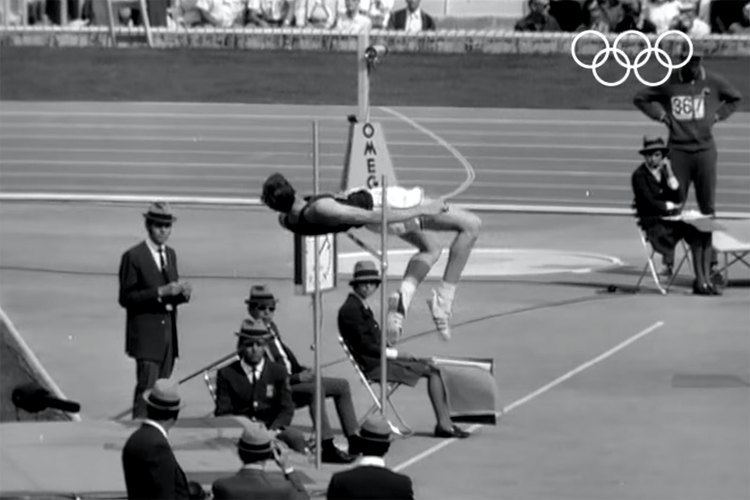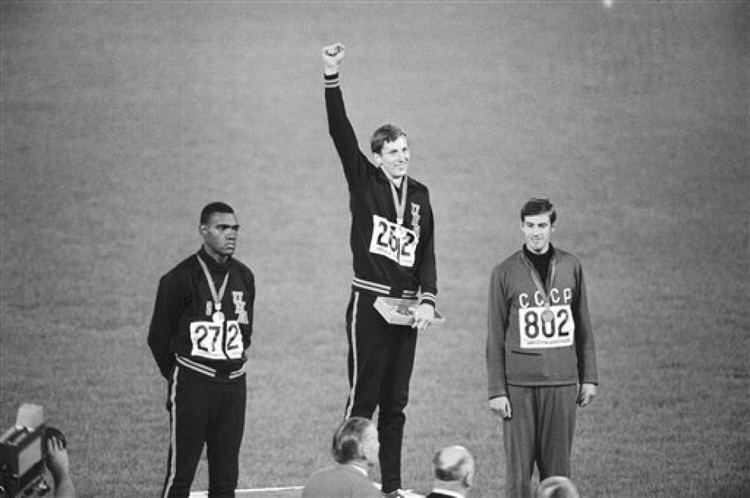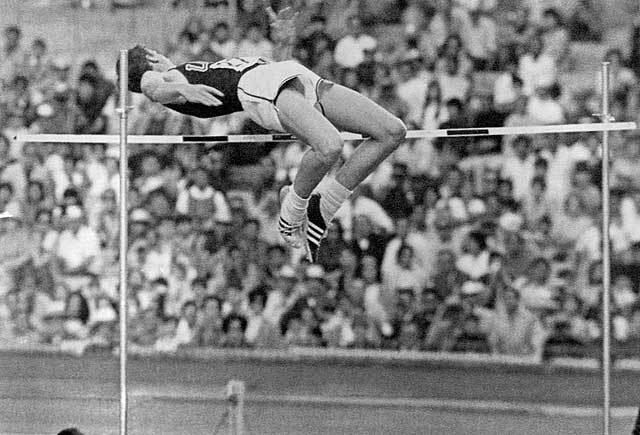Country United States Role Athlete Name Dick Fosbury | Personal best(s) 2.24 m (1968) Weight 83 kg Sport Athletics Height 1.93 m | |
 | ||
Similar People Peter Norman, Brian Keane, David Hirschfelder | ||
Legend of athletics dick fosbury signature edition
Richard Douglas Fosbury (born March 6, 1947) is an American retired high jumper, who is considered one of the most influential and inspirational athletes in the history of track and field. Besides winning a gold medal at the 1968 Olympics, he revolutionized the high jump event, with a unique "back-first" technique, now known as the Fosbury Flop, adopted by almost all high jumpers today. His method was to sprint diagonally towards the bar, then curve and leap backwards over the bar, which gave him a much lower center of mass in flight (it was actually below his body) than traditional techniques. He continues to be involved in athletics and serves on the executive board of the World Olympians Association. In 2014 Fosbury ran for a seat in the Idaho House of Representatives.
Contents
- Legend of athletics dick fosbury signature edition
- Dick fosbury interview developing the fosbury flop olympic rewind
- High school and the origins of the Fosbury Flop
- College
- Fosbury at the 1968 Summer Olympics
- Athletic legacy and the dominance of the flop
- Political career
- Personal life
- References

Dick fosbury interview developing the fosbury flop olympic rewind
High school and the origins of the Fosbury Flop

Fosbury, who was born in Portland, Oregon, first started experimenting with a new high jumping technique at age 16, while attending Medford High School. Fosbury had difficulty competing using the dominant high jumping techniques of the period. In his sophomore year, he failed to complete jumps of 5 feet (1.5 m), the qualifying height for many high school track meets. This dominant technique, the straddle method, was a complex motion where an athlete went over the high jump bar facing down, and lifted his legs individually over the bar. Fosbury found it difficult to coordinate all the motions involved in the straddle method, and began to experiment with other ways of doing the high jump.

Fosbury later recalled, "I knew I had to change my body position and that's what started first the revolution, and over the next two years, the evolution." At first, he tried to use a technique known as the upright scissors method. In this method, a jumper runs upright towards the bar, facing forward, and during his jump lifts his straight legs one at a time over the bar. High jump rules stipulate only that competitors may only jump off one foot at takeoff: there is no rule governing how a competitor crosses the bar, so long as he or she goes over it.

As he began to experiment with this technique, he gradually adapted it to make himself more comfortable and to get more height out of it. Nonetheless, it was nowhere near as coordinated as a well-performed straddle method jump, and one historian has referred to Fosbury's early attempts as an 'airborne seizure', but during the latter part of his sophomore year and the beginning of his junior year, it began to produce results, and he gradually was able to clear higher jumps.

Gradually, Fosbury shifted his positioning during the jump, such that by his senior year he had begun to go over the bar backwards, head-first, curving his body over the bar and kicking his legs up in the air at the end of the jump. This required him to land on his back, but prior to his junior year, his high school had replaced its wood chip landing pit with a softer material, so he was able to land safely.
Luckily for Fosbury, replacement of landing surfaces with foam rubber was becoming common across the United States in the early 1960s. Sawdust, sand, or wood chip surfaces had been usable previously because jumpers using the scissors technique were able to clear the bar while upright and then land on their feet, while those using the Western Roll or Straddle made a three-point landing on their hands and lead leg. In the late 1950s, American colleges began to use bundles of soft foam rubber, usually held together by a mesh net. These bundles were not only much softer, but were also elevated about 3 ft (0.91 m) off the ground. By the early 1960s, American high schools were following the lead of the colleges in acquiring foam rubber landing pits. With the new, softer, elevated landing surface, Fosbury was able to land safely.
Fosbury's coaches at first encouraged him to continue practicing the straddle method, but abandoned that when his marks continued to improve. In his junior year, he broke his high school record with a 6 ft 3 in (1.91 m) jump, and the next year took second place in the state with a 6 ft 5.5 in (1.969 m) jump.
The technique gained the name the "Fosbury Flop" when in 1964 the Medford Mail-Tribune ran a photo captioned "Fosbury Flops Over Bar," while in an accompanying article a reporter wrote that he looked like "a fish flopping in a boat." Others were even less kind, with one newspaper captioning Fosbury's photograph, "World's Laziest High Jumper". Unbeknownst to Fosbury, Debbie Brill, a Canadian girl six years his junior, was concurrently developing a similar technique, which became known as the "Brill Bend".
College
After graduating from Medford High School in 1965, he enrolled at Oregon State University in Corvallis. The school's coach, Berny Wagner, believed that Fosbury would eventually achieve greater results using the western roll and convinced him to continue practicing the old technique through his freshman year, although he was allowed to use the "flop" in freshman meets. The debate over technique ended during Fosbury's sophomore year, however, when he cleared 6 feet 10 inches (2.08 m) in his first meet of the season, shattering the school record.
Fosbury later recalled:
After the meet, Berny came up to me and said, 'That's enough.' That was the end of Plan A, on to Plan B. He would study what I was doing, film it, and even start to try to experiment and teach it to the younger jumpers.
The national sports media began to take notice of the jumper from Oregon with the unusual style. He was on the cover of Track and Field News's February 1968 issue. Fosbury won the 1968 National Collegiate Athletic Association (NCAA) title using his new technique—the first of two consecutive titles—as well as the United States Olympic Trials.
Fosbury continued to refine his technique, developing a curved, J-shaped approach run. This allowed him to increase his speed, while the final "curved" steps served to rotate his hips. As his speed increased, so did his elevation. Fosbury made little-to-no use of his arms at takeoff, failing to "pump" them upwards, keeping them down, close to his body: the next generation of floppers would add an arm pump. Fosbury's key discovery was the need to adjust his point-of-takeoff as the bar was raised. His flight through the air described a parabola: as the bar went up in height, he needed more "flight time" so that the top of his arc was achieved as his hips passed over the bar. To increase "flight time," Fosbury moved his takeoff farther and farther away from the bar (and the pit). Jumpers have a natural tendency to be drawn in closer to the bar and it requires mental discipline to move out, rather than in. By way of comparison, classic Straddle jumpers plant their take-off foot in the same place every time, less than one foot away from a line parallel with the bar. Photographs of Fosbury attempting heights above 7 feet (2.1 m) show him taking off nearly 4 feet (1.2 m) out from the bar.
In the 1968 outdoor season, Fosbury won the PAC-8 Conference title and went on to win the NCAA championship at Knoxville, Tennessee in mid-June with a jump of 7 feet 2.5 inches (2.197 m). He duplicated those wins the following year (1969).
Fosbury at the 1968 Summer Olympics
Fresh off his NCAA win in mid-June, Fosbury went on to win the US Olympic Trials two weeks later in Los Angeles with a jump of 2.16 m (7' 1"). Despite the win, his place on the Olympic team was not assured because the US Olympic Committee was worried that the results at sea-level Los Angeles might not be replicated at the high altitude in Mexico City. Another competition was held in September at the Olympic camp at South Lake Tahoe, California. At that competition, Fosbury was one of four men to clear 2.18 m (7' 2"), but he was in fourth place because of misses. The bar was raised to 2.20 m (7' 3"), a height none of the four had ever cleared. However, Olympic veteran Ed Caruthers, high schooler Reynaldo Brown and Fosbury all cleared on their first attempts. When the fourth man, John Hartfield, another high schooler who had been leading the competition, missed all three of his attempts, the Olympic team of three jumpers was set.
At the 1968 Olympics in Mexico City, Fosbury took the gold medal and set a new Olympic record at 2.24 meters (7 ft 4¼ in), displaying the potential of the new technique. Despite the initial sceptical reactions from the high jumping community, the "Fosbury Flop" quickly gained acceptance. In the Finals competition, only three jumpers cleared 2.20 meters (7 ft 2½ in), and Fosbury was in the lead by virtue of having cleared every height on his first attempt. At the next height, 2.22 m (7 ft 3¼ in), Fosbury again cleared the bar on his first jump. His teammate, Ed Caruthers, cleared on his second effort, while Valentin Gavrilov of the Soviet Union missed on all three attempts and earned the bronze medal (third place). The bar was raised to 2.24 meters, which would be new Olympic and United States records. Fosbury missed on his first two attempts, but cleared on his third, while Caruthers missed on all three of his attempts. Having won the gold medal and broken the American record, Fosbury asked the bar to be raised to 2.29 m, hoping to break Valeriy Brumel's 5-year-old world record of 2.28 m. However, none of his attempts at 2.29 m came close to clearing.
Athletic legacy and the dominance of the flop
Four years later, in Munich, 28 of the 40 competitors used Fosbury's technique, although gold medalist Jüri Tarmak used the straddle technique. By 1980, 13 of the 16 Olympic finalists used it. Of the 36 Olympic medalists in the event from 1972 through 2000, 34 used "the Flop". Today it is the most popular technique in modern high jumping.
In 2013, Fosbury's high jump appeared in a Mazda commercial portraying "Game Changers" and, with Fosbury himself, in an ad for Wuaki TV.
In 2015, Avicii released the music video for "Broken Arrows" (with lyrics by Zac Brown) that is loosely based on Fosbury's high jumping story and personal life.
Political career
In fall 2014, Fosbury ran as a Democrat for a seat in the Idaho House of Representatives against incumbent Republican Representative Steve Miller. Miller won the election.
Personal life
Fosbury graduated from Oregon State University in 1972 with a degree in civil engineering and is the co-owner of Galena Engineering, Inc. in Ketchum, Idaho, where he has lived since 1977.
In March 2008, Fosbury was diagnosed with stage one lymphoma. He had surgery a month later to remove a cancerous tumor engulfing his lower vertebra. Due to concerns about the tumor's proximity to the spine, it was not completely removed and he was put on a chemotherapy regimen. In March 2009, Fosbury announced that he was in remission. In March 2014 he declared in an interview with the Corvallis Gazette-Times that he was "doing well" and was "clear of cancer."
During the 2008 edition of "Sport Movies & TV - Milano International FICTS Fest" Fosbury was awarded with the Excellence Guirlande D'Honneur and entered in the FICTS "Hall Of Fame".
Dick Fosbury is today a member of the "Champions for Peace" club, a group of 54 famous elite athletes committed to serving peace in the world through sport, created by Peace and Sport, a Monaco-based international organization.
Fosbury and fellow Olympians Gary Hall and Anne Cribbs are founders of World Fit, a non-profit organization that promotes youth fitness programs and Olympic ideals.
